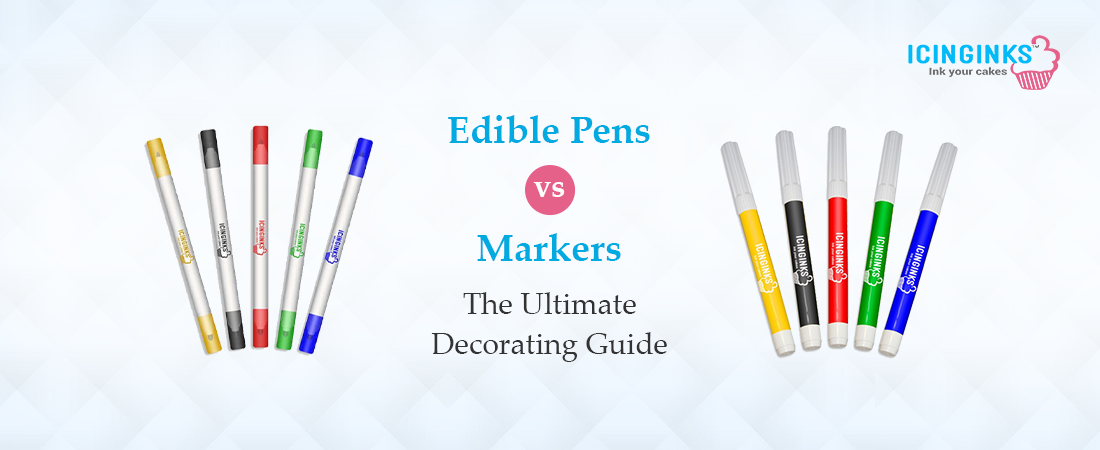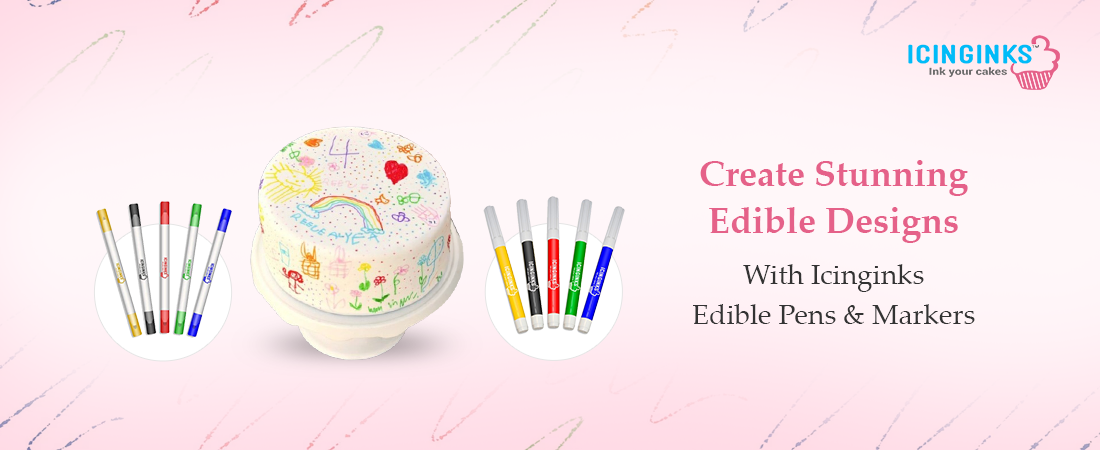
Decorating cakes and cookies often involves more than just frosting and sprinkles. For those who want to add intricate designs and personalized messages, edible pens and markers are invaluable tools. While both add detailed touches to your baked goods, understanding the differences between edible pens and edible markers can help you make the right choice for your decorating needs.
Understanding Edible Pens
What Are Edible Pens?
Edible pens are specially designed writing instruments that use food-safe ink. They resemble traditional pens in appearance but are filled with edible ink, making them perfect for adding detailed decorations to your baked goods. Edible pens are often used to write messages, draw fine lines, and create intricate designs that require precision.
Features of Edible Pens
- Precision: Edible pens are known for their fine tips, which allow for detailed and accurate work. This makes them ideal for writing names, creating fine outlines, and adding small decorative elements.
- Ease of Use: Edible pens are easy to handle and control with a design similar to regular pens. This familiar grip can make them more accessible for beginners and those who are new to cake decorating.
- Versatility: Edible pens are suitable for various surfaces, including fondant, gum paste, and even some types of frosting. This versatility makes them a valuable tool for creating various designs.
Exploring Edible Markers
What Are Edible Markers?
Edible markers, on the other hand, are broader and come in a variety of tip sizes, including broad and fine tips. They also use food-safe ink, but their design and application vary from edible pens. Edible markers are typically used for coloring larger areas or creating bold outlines.
Features of Edible Markers
- Variety of Tip Sizes: Edible markers come in different tip sizes, which makes them suitable for various applications. You can choose from fine tips for detailed work or broad tips for larger areas.
- Color Range: Edible markers often offer a wider range of colors than edible pens. This allows for more vibrant and diverse designs on your baked goods.
- Application Techniques: Edible markers can be used for detailed work and larger surface coverage. They are particularly useful for coloring larger areas or adding bold designs to cakes and cookies.
When to Use Edible Pens
1. Detailed Writing and Fine Designs
Edible pens are your best choice for tasks requiring precise lines and detailed writing. Their fine tips allow you to create intricate designs and write messages. If you need to add small text or detailed patterns, edible pens provide the control and accuracy needed for these tasks.
2. Personalization
Edible pens are perfect for personalizing baked goods with names, dates, or special messages. Whether preparing a birthday cake, wedding cookies, or holiday treats, edible pens enable you to add a unique and memorable personal touch.
3. Decorating Small Items
When decorating smaller items like cupcakes or cookies, edible pens offer the precision to create detailed designs without overwhelming the tiny surface area. Their ability to create fine lines and small details makes them ideal for these smaller decorating projects.
When to Use Edible Markers
1. Coloring Large Areas
Edible markers are better suited for coloring larger areas or creating bold designs. Suppose you need to cover a significant portion of a cake or cookie with color. Due to their broader tips and greater ink capacity, edible markers can accomplish this more efficiently.
2. Creating Bold Designs
For vibrant, eye-catching designs, edible markers offer a range of colors and tip sizes that can help you achieve the desired effect. Whether adding large patterns or bold outlines, edible markers provide the coverage and color intensity needed for such designs.
3. Versatile Applications
Edible markers can be used for various decorating techniques, including blending colors, adding shading, or creating gradient effects. Their versatility makes them a valuable tool for those who enjoy experimenting with different decorating styles and techniques.
Choosing Between Edible Pens and Markers
1. Consider Your Project Needs
When deciding between edible pens and edible markers, consider the specifics of your decorating project. If you require fine detail and precision, edible pens are the way to go. For larger areas and bold designs, edible markers will serve you better.
2. Think About Surface Types
The type of surface you are decorating also influences your choice. Edible pens work well on surfaces like fondant and gum paste, where precision is crucial. Edible markers are effective on a broader range of surfaces and can be used for fine and large-scale designs.
3. Evaluate Your Skill Level
Your experience with cake decorating may also influence your choice. Edible pens are straightforward and familiar, making them suitable for beginners. With their various tip sizes and color options, edible markers offer more creative possibilities for those with more experience.
Making the Right Choice
In summary, edible pens and markers have unique advantages and applications in cake and cookie decorating. Edible pens are ideal for detailed work and personalization, while edible markers are better suited for larger areas and bold designs. By understanding the differences and uses of each tool, you can make informed decisions and enhance your decorating projects with precision and creativity. Whether you opt for edible pens or markers, both can improve your baking creations and make your treats memorable.
Create Edible Masterpieces with Icinginks' Premium Pens and Markers

When it comes to precision and versatility in cake and cookie decoration, Icinginks offers a premium range of edible pens and markers to meet all your creative needs. Whether you're crafting intricate details or bold designs, Icinginks has the perfect tools for both beginners and professionals.
Icinginks' Double Tip Edible Markers provide unmatched flexibility, featuring a fine tip for detailed work and a broader tip for covering larger areas. These markers are perfect for easily adding vibrant color to cookies, cakes, and fondants. The dual tips allow seamless transitions between outlining and filling, making them ideal for versatile decorating tasks.
For those who need precision, Icinginks' Fine Tip Edible Ink Markers are designed to create thin, delicate lines, perfect for intricate designs or small text on cakes and cookies. If you aim for bold statements, the Standard Tip Edible Ink Markers deliver strong, consistent strokes that enhance your designs with vivid color.
Icinginks' edible pens and markers are made from high-quality, food-safe ink, ensuring that your decorations are stunning and safe to eat. Explore our collection today and improve your cake decorating game with professional results!
FAQs
What’s the main difference between edible pens and edible markers?
Edible pens have finer tips and are ideal for detailed designs and writing, while edible markers offer broader tips for coloring larger areas or bold outlines. Both use food-safe ink, but their specific uses depend on your decorating needs.
Can edible pens and markers be used on all types of frosting?
Edible pens and markers work best on smooth surfaces like fondant, royal icing, or gum paste. They may not perform as well on softer, wet surfaces such as buttercream due to smudging or ink absorption.
How long do designs created with edible pens last?
Designs made with edible pens can last several days, especially on fondant or gum paste. However, for the best appearance, decorating closer to the serving time is recommended, as moisture can affect the design over time.
Can I blend colors with edible markers?
Yes, edible markers can blend colors, especially on smooth surfaces like fondant. This technique allows you to create gradient effects, shading, or more complex designs on your baked goods.
More interesting blogs to read on Icinginks
The Ultimate Guide to Cake Printer Maintenance and Troubleshooting
Wafer Sheets: A Budget-Friendly Solution for Event Décor
A Guide to Edible Fabric Sheet Stencils: Tips and Tricks
Selecting the Right Edible Ink for Your Cake Decorating
How to Print Edible Images on Cookies: A Step-by-Step Guide




